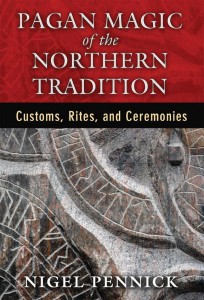Review: Pagan Magic of the Northern Tradition, Nigel Pennick
Destiny Books has my number. They have released several titles relating to Northern Traditions this year, and kindly sent me a copy of Pagan Magic of the Northern Tradition: Customs, Rites, and Ceremonies, the latest from Nigel Pennick.
If you are not familiar with Pennick’s work, this is a very good place to start. Pennick is a serious scholar, and his work is peppered with notes and cross-references. The book contains a 15 page glossary and a 30 page bibiliography. Be still, my beating academic heart!
Pennick is also an entertaining writer, so the book, while densely packed with information, is pleasurable to read. The research is extensive, the anecdotes are relevant, and the breadth of topics covered is delightful.
The book opens with an introduction to Northern Magic to acquaint the reader with basic concepts and terms, and sets an engaging tone for the text. Subsequent chapters cover a myriad of facets of daily life–measuring time, measuring distance, crafting, building construction, social justice, funeral customs, music, and countless quotidian details which add richness to our understanding of how people lived. Who knew that a simple pothook was also a powerful magical object? I didn’t, but now I do.
A plethora of photos, drawings, and diagrams are quite helpful for understanding some of the less-familiar concepts and narrative in the book, especially in the chapters dealing with measurement of distance and building.
Pennick explores how our ancestors used practical magic on a daily basis to manage their lives. Much was beyond their control, and much is still beyond our control, despite our scientific advances and technical inventions. Pennick draws a direct connection between us and our forebears:
“We are within our given circumstances, living in our own lives, and must endure their accompanying difficulties, but how we endure them and how we deal with our circumstances is up to us.” (Page 15)
Each chapter is a balanced combination of history, theory, anecdote, and philosophy. The definition of “Northern” is generous, and covers the expected Nordic, Scandinavian, and Germanic areas, and also branching out east and south to the Baltic and Slavonic territories, and west to the British Isles.
Pennick provides plenty of examples of invocations, chants, and common practices to give a full picture of our ancestors’ daily lives. Whether they were creating wooden charms to keep the horses safe in the stable, or building houses in alignment with earth energies and divine geometry, our forebears were using the tools and knowledge available to them create a human space in a wild world. They kept an amazingly accurate calendar of events to honor their Gods and the Wheel of the Year, and their adherence to these traditions to keep them grounded in a hard world gives us a strong example to follow in our own different, but not entirely dissimilar, world.
Where our ancestors used chants, sigils, and specific rituals, we have our own magic of wireless signals and social rituals. In their efforts to create a safe space for a happy home, to reckon time, and to honor life, we see our own efforts–the same intent, but rather different in form–as we practice them today. Pennick’s message of the need for “Keeping Up the Day” come through clearly, and his book is packed with ideas we can adapt to continue our ancestors’ traditions in ways that make sense for us and our world.

